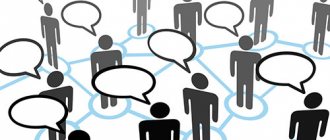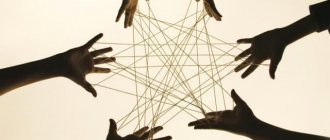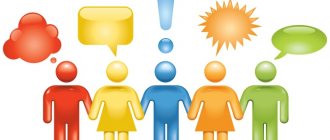The most annoying thing about being a person who always gesticulates heavily is that the more animated the conversation becomes, the higher the likelihood of knocking over a glass of red wine at the dinner table or accidentally hitting a stranger on the subway. Apart from the fact that gesturing brings success in interviews and dating, the above is further awkward evidence that gestures are cognitive - an idea supported by an impressive amount of psychological literature.
Traditionally, speech is thought of as a “private party” for the brain and larynx, with no room for the rest of the body. It’s not for nothing that the hosts of central TV channels are called “talking heads.” Thanks to René Descartes and a whole pantheon of other serious white men, Western intellectual history has long argued that thought is something that happens only in the realm of the brain. And as educator Ken Robinson once sarcastically noted, the body's job is only to carry the brain from one meeting to another. However, our hands indicate otherwise.
Gesture research
Susan Goldin-Meadow, a psychologist at the University of Chicago, has spent much of her career trying to understand what happens when people talk using their hands. She notes that a gesture that accompanies speech is different from an ordinary action, such as picking up a cup of coffee or combing one's hair, and it is different from a movement that is an end in itself, such as in a dance, ritual, or exercise.
The movements that hearing people make are also quite different from sign language. Goldin-Meadow says that usually in communication, units of expression and signs relate only to other signs. But in gesturing, hand movements are unclear, and they only make sense in conjunction with what is being said at that moment. “Gesticulation is not divorced from speech, it is completely tied to it,” says the psychologist in the journal Science of Us. “It’s part of learning, not just mindless hand waving.”
Researchers haven't yet been able to pinpoint exactly how this connection works, but Goldin-Meadow is confident that part of the connection is because gestures reduce what's called "cognitive load," or the amount of mental energy it takes to store data in working memory (a.k.a. RAM is a type of memory that determines the ability to “keep in mind” fragments of information necessary for momentary mental activity).
Goldin-Meadow began her career studying deaf children of hearing parents who are not exposed to standardized sign language and develop their own sign system. Since then, she has been researching the role of gestures in learning and speaking. Goldin-Meadow and colleagues found that when babies point to objects, they are more likely to remember their names; For adults, gesturing helps trigger memories when trying to remember a set of numbers, and for elementary school students to better understand mathematical principles.
A selection of useful events
Nonverbal is “body language” in a broad sense: the transmission of information through gestures, smells, taste, voice, visual signals. Nonverbal means of communication contribute to the creation of psychological contact between partners, enrich the meanings conveyed by words, and reflect the interpretation of the situation. Factors influencing the non-verbal side of communication are national characteristics, health status, professional etiquette, social status, and membership in certain age groups.
Means of nonverbal communication
Experiment
Action: We want to make one part (take the first two numbers - 2 and 9) equal to the second (put the numbers in the empty space).
Specific gesture: We want to make one part (we move our hands as if we are taking the numbers, but in fact we do not touch them) equal to the other part (we pretend to put the numbers on an empty space).
Abstract gesture: We want to make one part (we make a V-shaped gesture under the first two numbers) equal to the other part (we point to an empty space).
In this study, Goldin-Meadow and her colleagues divided 90 third-graders into three groups and tried to teach them the example of equality (2+9+4=__+4). In the “Action” group, students moved plastic numbers on the board following the instructor’s lead; in the “Concrete Gesture” group, children imitated the same actions, but did not touch objects; and in the “Abstract Gesture” group, students used V-shaped gestures.
Pose and its details
Significant information about a person’s internal mood is provided by the static position of his body.
At the same time, a frequently repeated pose communicates stable personality traits. Auditing company KAMERTONVerified profileHelp of auditorsWe will advise, help correct mistakes, issue an opinion Find out moreAdvertising on Clerk Since in changes of feelings people usually control their face better than their body, often it is not facial expressions, but posture that can tell about the true experiences of an individual.
Possible connections between body positions and a person’s mental state are as follows:
- hands clasped behind the back, head raised high, chin pointed out - a feeling of self-confidence and superiority over others;
- the body is leaned forward, hands (akimbo) on the hips - self-confidence and readiness for active action, aggressiveness, nervousness when talking, the desire to defend one’s position to the end;
- standing with your hands on a table or chair - a feeling of incomplete contact with your partner;
- hands with elbows spread behind the head - awareness of superiority over others;
- putting your thumbs in your belt or in pocket slots is a sign of aggressiveness and demonstrated self-confidence;
- sticking your thumbs out of your pockets is a sign of superiority;
- crossed limbs - skeptical defensive attitude;
- uncrossed limbs and an unbuttoned jacket - establishing trust;
- tilting the head to the side - awakening interest;
- tilting the head down - a negative attitude;
- a slight tilt of the head back is a sign of aggressiveness;
- sitting on the tip of a chair - the readiness to jump up at any moment in order to either leave, or act in the current situation, or to calm the accumulated excitement, or to attract attention and join the conversation;
- crossing your legs over your legs and crossing your arms over your chest is a sign of “disconnecting” from a conversation;
- throwing your leg over the armrest of a chair (while sitting on it) - disdain for others, loss of interest in conversation;
- crossed ankles of a person sitting - holding back a disapproving attitude, fear or anxiety, an attempt at self-control, a negative defensive state;
- position (sitting or standing) with legs oriented towards the exit - a clear desire to stop talking and leave;
- frequent changes of posture, fidgeting in a chair, fussiness - internal restlessness, tension;
- standing up is a signal that a certain decision has been made, the conversation is boring, something surprised or shocked;
- clasped fingers - disappointment and the desire to hide a negative attitude (the higher the hands are located, the stronger the negative);
- the hands are connected by the fingertips, but the palms are not touching - a sign of superiority and confidence in oneself and in one’s words;
- hands rest with their elbows on the table, and their hands are located in front of the mouth - hiding their true intentions, playing cat and mouse with a partner;
- supporting the head with the palm of your hand - boredom;
- fingers clenched into a fist are located under the cheek, but do not serve to support the head - a sign of interest;
- resting your chin with your thumb is a sign of some kind of critical assessment;
- clasping your glass with both hands is a disguised nervousness;
- blowing smoke from a cigarette upward - a positive attitude, self-confidence;
- blowing smoke from a cigarette downward - a negative attitude, with hidden or suspicious thoughts.
Physiognomy
When we perceive another person, we first turn our attention to his head, to his face, in the hope of getting the most important information from there. The human face retains traces of the most common and typical experiences and thoughts. Moreover, these characteristics are probably fixed in the gene pool and are hereditary, as well as a tendency to certain psychological reactions.
Wrinkles. Wrinkles are very informative. For example, someone who raises his eyebrows and frowns during a conversation is vain, narcissistic, internally anxious, ambitious and lacking common sense. A frequent “frown” on the eyebrows indicates an irritable and contradictory mind, a suspicious and grumpy character. Vertical lines of gloomy color indicate strong mental stress and extremely strong will.
Brows. Eyebrows located close to the eyes and running horizontally from the nose to the temples indicate steadfastness and determination. Eyebrows located very far from the eyes, slightly arched and narrow, indicate a weak, careless and passive character. If the eyebrows are angular, it indicates a lack of balance on the part of the owner. Eyebrows pushed above the eyes are a sign of a silent nature suffering from ambition, envy and jealousy. Bushy and tousled eyebrows indicate a contradictory and contradictory character, while knitted eyebrows indicate melancholy, mistrust and jealousy.
Eyes. Very bulging eyes indicate love, a heavy mind and a lack of common sense. Sunken and moving eyes show a shift, and small sunken eyes are a sign of envy and deception. The eyes are not bulging or sunken, but represent, as in the middle, balanced mental and moral qualities. Mobility of the eyes is often associated with boasting, suspicion, mistrust, a tendency to anger and blinking - with shyness, cunning or deceit.
Even eye color can provide specific information. People with dark eyes have more energy, initiative and a more restless nature than people with light eyes. Gray eyes are usually people who react quickly to changing situations and can overcome any difficulties. Blue eyes are deceiving. They want to find dreaminess and naivety. In fact, the opposite is true: these are the eyes of people who stubbornly seek goals, relying more on reason than on intuition. Blue-eyed people are easily influenced by impulses, but they are also cool and easy. Their positive qualities are true. Blue eyes are characteristic of people with high vitality. These people are blessed with organizational skills, vision and a brilliant way of communicating with people. Brown eyes are characteristic of choleric people who can work hard, full of energy and perseverance, with a strong will. However, such people sometimes allow themselves impulsive, thoughtless actions, partly because they do not know what others expect of them. Black eyes symbolize independence and the desire to rule. However, the power of the black-eyed is expressed quite softly, without rudeness. But when obstacles get in the way of their goals, they can become aggressive. People with green (high sensuality, the ability to have strong feelings) and gray-green eyes usually have a strong will and strictly follow their goals. They are persistent, but can also be tough and unwavering.
Mouth. People with thin lips are dry, calculating and thrifty by nature, and do not like chatter and theatricality. As a rule, they are very successful in financial transactions, which cannot be said about people who are characterized by generosity and openness. In impulsive people, the mouth tends to be forward. The upper lip rising slightly above the lower lip indicates intelligence, alertness and directness. A large and irregular mouth is a sign of impudence. A moderately large and slightly curved mouth with firm and almost equally prominent lips indicates the courage and determination of its owner.
Chin. A small round chin betrays a person who is shy and lacks willpower. A prominent square chin belongs to a person with energy, determination and ambition. A medium, rounded and moderately pronounced chin is an indicator of a balanced person. Flat chins are often cold and dry and overly ambitious. A large, round, thick, double chin indicates a person with strong sensuality and drive. Eccentricity, fussiness, irritability and a tendency to cause controversy are often a product of clefts and prominent chins.
Basic aspects of nonverbal communication
Attempts to determine the connection between a person’s appearance and his character were made by Aristotle, who is one of the founders of the doctrine of physiognomy. However, according to some historians, before Aristotle, Pythagoras studied physiognomy. Beginning with the teachings of Aristotle, the great scientists of Ancient Greece and Ancient Rome were the leaders of physiognomy. Since the 15th century, physiognomy has gained great popularity. Everyone who “worked with people” did this seriously: Clerics, doctors, philosophers and lawyers.
The language of the human body, which plays an almost central role in social communication and largely determines the individual success of each person, has occupied scientists since Ancient Rome, as confirmed by Cicero in his work “On the Orator”.
Professional and targeted research into various aspects of body language began around the 60s of the twentieth century. (D. Morris, Jay Fast, I. Hall and others). The expressive repertoire of a person and his psychological characteristics as a unit. This phenomenon was carefully studied under the leadership of A.A. Bodaleva (1965). Today we also have outside research at our disposal that helps us “read a person like a book,” “deciphering” his expressive repertoire.
Theoretical knowledge about nonverbal behavior is often used in practice in social and psychological training programs aimed at increasing self-esteem and individual success. And in collective training in the workplace to improve work efficiency.
The largest foreign center for teaching the basics of nonverbal communication is Pease Trading Corporation (Australia), founded by A. Pease.
On the topic: methodological developments, presentations and notes
Didactic games, dynamic pauses and mini-studies on developing sensitivity in children to verbal and non-verbal means of communication.
Preschool teachers should more often use sketch games in classes and outings that help develop children’s sensitivity to verbal and nonverbal means of communication.
In these games, children communicate with help... Seminar-workshop on the topic: “Forms of working with children on the development of verbal and non-verbal means of communication”
In the conditions of the Federal State Educational Standard for Education, the formation of non-verbal means of communication, the correction of deficiencies in the emotional sphere should be considered as priority educational tasks, since only an agreed combination...
presentation “Forms of working with children on the development of verbal and non-verbal means of communication”
presentation for the interactive whiteboard.
Theoretical and practical part…. Workshop for teachers “Verbal and nonverbal means of communication with children”
Usually, when communicating with others, we pay attention to the verbal content of the message and the most obvious nonverbal signs;
smile, facial expression (sadness, joy), folding hands. More difficult street... “Verbal and nonverbal means of communication”
This material will help in working with preschool children...
Consultation for teachers of preschool educational institutions “Verbal and nonverbal means of communication”
Consultation for teachers of preschool educational institutions “Verbal and nonverbal means of communication”...
Verbal and nonverbal means of communication
Verbal and non-verbal means of communication...
- I like
Sources used:
- https://revolution.allbest.ru/psychology/00236792_0.html
- https://www.klerk.ru/boss/articles/409640/
- https://srazu.pro/socializacia/neverbalnoe-obshhenie-v-psixoloii.html
- https://nsportal.ru/detskiy-sad/raznoe/2015/05/21/verbalnye-i-neverbalnye-sredstva-obshcheniya
Types of nonverbal communication
Gestures
The placebo effect - what is it in psychology?
Non-verbal gestures include pronounced movements of the head, hands, fingers, accompanying statements and thoughts. If people need to pay attention to objects, they will need the help of pointing gestures. Emphasizing gestures reinforce statements. A demonstrative movement of the brush explains the state of affairs. Touching a partner helps to establish social contact or receive a sign of attention, weakening the significance of information. Gestures are performed in voluntary and involuntary forms.
Pose
Postures must follow the rules of etiquette. Open poses of a sitting girl in Europe and America have neutral meanings; in Japan they are considered immoral. The squatting position of adults in most countries has an indecent definition; in South America and Africa, many peoples rest in a similar form. Using a chair is assessed as aggression.
Poses of strength and weakness
Postures during a public address or business conversation should express openness: arms unclasped, legs uncrossed, back straight. If you lean forward a little, your posture will be perceived as interest in an understandable topic. Slouching communicates uncertainty, while wide-set legs and arms indicate dominance. Tapping with a hand or foot is a manifestation of boredom, lack of time, impatience. The interlocutor took a closed posture - this may mean that the person does not believe or does not perceive the information well. The legs are turned towards the exit, the person wants to leave. The head is tilted forward, the interlocutor listens carefully and analyzes.
Facial expressions
Facial expressions are commonly called expressive movements of the facial muscles in order to express certain feelings of an individual. The types of facial expressions correspond to the functions of the psyche: mental acts are expressed by the muscles around the eyes, the perioral muscles are associated with acts of will. Feelings are emphasized by the general muscles of the face, changing in conscious and involuntary forms.
Various forms of facial complexes are possible:
- Amymia is the absence of visible facial changes.
- Tension can be indicated by a tight closure of the mouth and a petrified state of the upper part of the face.
- Interest can be easily recognized by a slight raising or lowering of the eyebrows, a slight widening and narrowing of the eyelids. The field of view increases, the focusing of the eyes becomes sharper.
- A smile can refer to calming or distracting from aggressive behavior, and is used when greeting.
Facial expressions convey basic emotions (joy, sadness, anger, surprise, disgust), provided by innate neural programs, as well as false information.
Facial display of emotions
Distance
The norms of approach between two people are defined in science by four intervals:
- Intimate. A length of 0...45 cm is considered optimal for communication between close people.
- Personal. A gap of 45...120 cm is maintained when communicating with familiar people.
- Social. A distance of 120...400 cm is recommended for official negotiations and conversations with strangers.
- Public. At a distance of 400...750 cm, it is not considered rude to exchange a couple of phrases; this interval is observed when speaking in front of an audience.
According to the teachings of social science, the rules vary for people of different ages, gender, and social status. For example, children and old people stay closer to their interlocutor, compared to teenagers. Men occupy distant positions, unlike women. A calm person gets as close as possible, an unbalanced person stays further. People address interlocutors of higher status at a great distance. Nationality also plays a role. Asians interact over shorter periods than Europeans, city dwellers are closer to settlers in sparsely populated areas.
Intonation
Prosody (voice tone, timbre, sound intensity, pauses) regulates the flow of speech, complements or replaces statements, and expresses the emotional state. It is important to be able to hear the intonation structure of speech, evaluate the strength and tone of voice, speed of speech, expressing the feelings and thoughts of the interlocutor:
- excitement is manifested by a low tone of voice, fast, abrupt speech;
- enthusiasm is demonstrated by a loud voice and clear, confident speech;
- fatigue can be easily determined by a low tone of voice, weakening of intonation towards the end of a sentence;
- signs of arrogance can be slow speech, even monotonous intonation;
- uncertainty is felt by interlocutors who make mistakes in words, frequent pauses, and nervous coughing.
The voice contains a lot of information about the owner. Experienced voice specialists are able to study the age, place of residence, character and temperament of the owner. People who have the ability to dramatically change the pitch of their voice are more sociable, more confident and pleasant than monotone or uncertain interlocutors.
Clothes speak about a person
Cloth
When forming an image, a person tries on a role in society and internal positions. The key characteristic is not fashion, but the style direction and color scheme. Extroverts rely on bright, rich colors. Introverts choose dark tones, nondescript, halftones, black, bed, beige, gray. Bright and large jewelry can also be a means of demonstrating a person’s egocentrism and high status (or the individual himself desires it).
Nonverbal communication what is it in psychology
Nonverbal communication is a type of communication without the use of words (through images, intonation, gestures, facial expressions). The tools for influencing a person are:
- sight;
- interpersonal space;
- optical-kinesthetic signals (facial expressions, appearance of the interlocutor, pantomime);
- peri-speech factors – vocal range, vocal qualities, timbre;
- extra-speech (laughter, speech rate, pauses).
For your information. Nonverbal methods of communication improve mutual understanding between people, allow you to predict the mood and attitude of the interlocutor towards the individual, and predict your own communication model.









